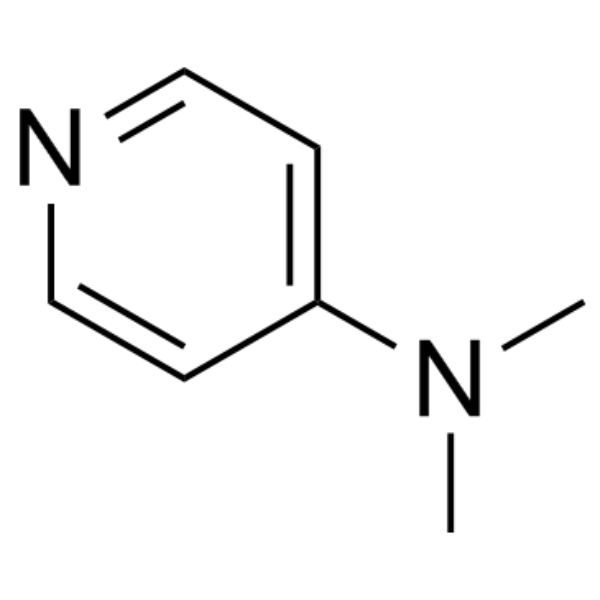Chemical Properties:
Package: Bottle, Aluminium foil bag, 25kg/Cardboard Drum, or according to customer's requirement. Storage Condition: Store in sealed containers at cool and dry (≤10℃) warehouse away from incompatible substances. Protect from light and moisture. Shipping: Deliver to worldwide by FedEx / DHL Express. Provide fast and reliable delivery. Shanghai Ruifu Chemical Co., Ltd. is the leading manufacturer of 4-Dimethylaminopyridine (DMAP) (CAS: 1122-58-3 ) with high quality. Ruifu Chemical can provide worldwide delivery, competitive price, small and bulk quantities available. Purchase DMAP, Please contact: alvin@ruifuchem.com| Item | Specifications |
| Appearance | White or Off-White Crystalline Powder |
| Purity / Analysis Method | >99.0% (HPLC) |
| Melting Point | 110.0~114.0℃ |
| Insoluble In Water | <0.10% |
| Moisture (K.F) | <0.30% |
| Loss On Drying | <0.50% (Under Vacumn For 3 Hour At 60ºC) |
| Single Impurity | <0.50% |
| Total Impurities | <1.00% |
| Infrared Spectrum | Consistent with Structure |
| 1 H NMR Spectrum | Consistent with Structure |
| Test Standard | Enterprise Standard |
Description:
Specifications:
Package & Storage:
| Chemical Name | 4-Dimethylaminopyridine |
| Synonyms | DMAP; 4-(Dimethylamino)pyridine; N-(4-Pyridyl)dimethylamine; N,N-Dimethylpyridin-4-Amine; N,N-Dimethyl-4-Pyridinamine; gamma-(Dimethylamino)pyridine |
| CAS Number | 1122-58-3 |
| Stock Status | In Stock, Production Capacity 40 Tons per Month |
| Molecular Formula | C7H10N2 |
| Molecular Weight | 122.17 |
| Melting Point | 110.0~114.0℃ |
| Boiling Point | 190℃/150 mmHg |
| Density | 0.906 g/mL at 25℃ |
| Refractive Index | n20/D 1.431 |
| Solubility in Methanol | Very Faint Turbidity |
| Solubility in Water | Soluble in Water, 80 g/l 25℃ |
| Solubility (Very Soluble in) | Chloroform, Benzene, Methanol, Acetone |
| COA & MSDS | Available |
| Brand | Ruifu Chemical |
Advantages:
FAQ:
Stable Supply: Maintain reasonable stock
Professional Service: One stop purchasing service
Technical Support: Technology solution available
Custom Synthesis Service: Ranged from grams to kilos
Fast Delivery: If within stock, three days delivery guaranteed
High Quality: Established a complete quality assurance system
1122-58-3 - Risk and Safety:
1122-58-3 - Risk and Safety Risk Codes R25 - Toxic if swallowed R34 - Causes burns R24/25 - R36/37/38 - Irritating to eyes, respiratory system and skin. R27 - Very Toxic in contact with skin R36 - Irritating to the eyes R24 - Toxic in contact with skin R20 - Harmful by inhalation R61 - May cause harm to the unborn child R40 - Limited evidence of a carcinogenic effect R23/24/25 - Toxic by inhalation, in contact with skin and if swallowed. R67 - Vapors may cause drowsiness and dizziness R66 - Repeated exposure may cause skin dryness or cracking R21/22 - Harmful in contact with skin and if swallowed. R11 - Highly Flammable R36/37 - Irritating to eyes and respiratory system. R22 - Harmful if swallowed R19 - May form explosive peroxides Safety Description S36/37/39 - Wear suitable protective clothing, gloves and eye/face protection. S45 - In case of accident or if you feel unwell, seek medical advice immediately (show the label whenever possible.) S28A - S26 - In case of contact with eyes, rinse immediately with plenty of water and seek medical advice. S28 - After contact with skin, wash immediately with plenty of soap-suds. S36/37 - Wear suitable protective clothing and gloves. S53 - Avoid exposure - obtain special instructions before use. S27 - Take off immediately all contaminated clothing. S22 - Do not breathe dust. S16 - Keep away from sources of ignition. UN IDs UN 2811 6.1/PG 2 WGK Germany 3 RTECS US8400000 TSCA T HS Code 2942000000 Hazard Note Toxic/Corrosive Hazard Class 8 Packing Group II Toxicity LD50 orally in Rabbit: 140 mg/kg LD50 dermal Rabbit 90 mg/kgSufficient Capacity: Sufficient facilities and technicians
OEM Package: Custom package and label available

Application:
4-Dimethylaminopyridine (DMAP) (CAS: 1122-58-3) is a new highly efficiency catalyst widely used in chemical synthesis. It has high catalytic capacity in organic synthesis, drug synthesis, pesticide, dye, fragrance synthesis of acylation, alkylation, etherification and other types of reaction, and has a very obvious effect on improving yield. Acylation of alcohol; Acylation of phenols; Acylation of amines; Acylation of enolates; Reactions of isocyanates; Miscellaneous Applications; Transfer of Functional Groups. DMAP, is a super nucleophilic acylation catalyst. The resonance of the electron-donating dimethylamino group in its structure and the parent ring (pyridine ring) can strongly activate the nitrogen atom on the ring to undergo nucleophilic substitution, which significantly catalyzes high resistance, low-reactive alcohols and amines/acids The activity of the acylation/esterification reaction is about 104~106 times that of pyridine. Acyl transfer is a common transformation in nature and organic synthesis, in which chiral DMAP is a common asymmetric acyl transfer catalyst. Since 1996, Vedejs and Fu team reported the central chiral and planar chiral DMAP catalysts respectively, chiral DMAP catalysts have been greatly developed. Various central chiral, planar chiral, spiro chiral and central chiral DMAP have been reported one after another, and have been well applied in many asymmetric acyl transfer reactions. DMAP is a highly versatile nucleophilic catalyst for acylation reactions and esterifications. It is also employed in various organic transformations like Baylis-Hillman reaction, Dakin-West reaction, protection of amines, C-acylations, silylations, applications in natural products chemistry, and many others. DMAP can be used as a catalyst: For the acylation of alcohols with acid anhydrides under auxiliary base- and solvent-free conditions to synthesize corresponding esters. In Baylis-Hillman reaction to form carbon-carbon bond by the coupling of an activated alkene with an aldehyde or ketone. A highly efficient catalyst for acylation reactions.

